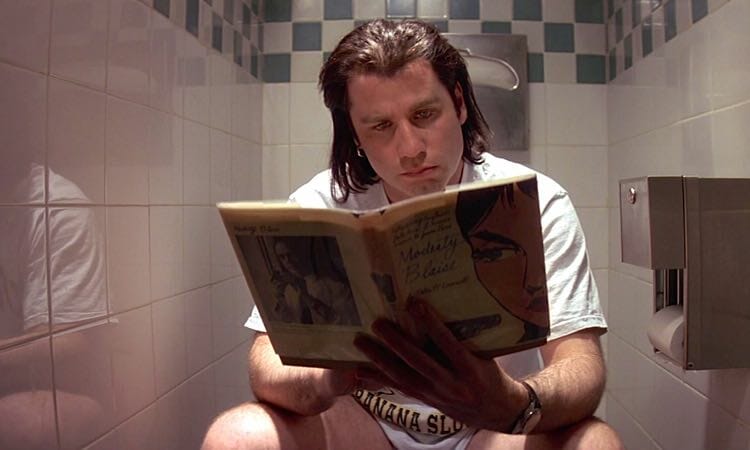By Carrie Stemke · November 2, 2014

It’s the film where we all learned what they called a Quarter Pounder with cheese in Paris: Quentin Tarantino’s Pulp Fiction is a witty, snappy, outrageous film and a take on Sin City-style film noir that only Tarantino could come up with. Tarantino combines a variety of elements that you wouldn’t think would go well together, and creates a spectacular result that manages to be a well-deserved hit while avoiding the usual “Hollywood formula” all at the same time.
Pulp Fiction combines the stories of a number of different characters into chapters in which their storylines sometimes merge. Bruce Willis is excellent in his role as Butch Coolidge, a prizefighter with a knack for getting himself into trouble (it would be his comeback role, alongside Travolta). Samuel L. Jackson and John Travolta play a couple of chatty hired thugs, Amanda Plummer and Tim Roth get involed as Pumpkin and Honey Bunny, two thieves with guns, and Christopher Walken has a cameo in a story about a watch. They’re joined by Harvey Keitel as a cleaner called “The Wolf,” Ving Rhames as a mobster named Marcellus Wallace, and (at the time) newcomer Uma Thurman as Mrs. Mia Wallace, whose dance with John Travolta’s Vincent Vega catapulted her to instant stardom.
The film is filled with now-iconic scenes that best express the variety of elements that make the pulp fiction genre a cult classic. Of particular note is the heart-pounding scene in which a frantic Vincent Vega, terrified at the thought of what might happen to an overdosing Mia Wallace (and what could transpire if her husband, Vega’s boss, finds out about the incident), races a sweating, barely-conscious Mia to the home of her drug dealer. This scene is accompanied by the fantastic line, “The day that I bring an OD-ing bitch over to your house, then I give her the shot.” The line perfectly illustrates the masterful ability of Tarantino to mix black comedy into an extremely serious situation, and reflects the essence of Pulp Fiction as a black comedy crime film filled with violence, fun and strangeness.
Perhaps one of the best things about Pulp Fiction is the way in which it has managed to become an Oscar-winning Hollywood classic without being the usual type of Hollywood classic. Its characters, plotline, and structure make one crazy, over-the-top movie that is certainly one of Tarantino’s best, and an excellent example of what happens when Hollywood takes time off from honoring the formulas and pays attention to truly great work.
Editor's Note: What also pushed this screenplay to the top of the deck is its dialogue driven base. Action writing, albeit noteworthy here, takes a back seat to the dialogue that is presented upfront, unapologetically. We first saw threads of this with True Romance, and then saw that style much more fleshed out in Reservoir Dogs. With Pulp Fiction, this style of writing is crisply edged to a point where it shines.